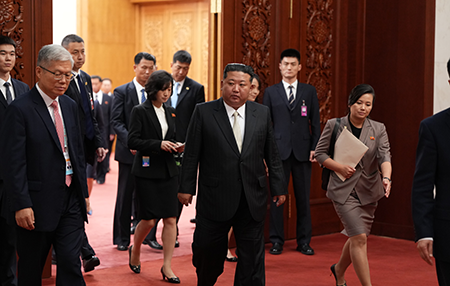"I want to tell you that your fact sheet on the [Missile Technology Control Regime] is very well done and useful for me when I have to speak on MTCR issues."
North Korea Rejects Talks With South Korea, Seeks Them With U.S.
October 2025
By Kelsey Davenport
North Korean leader Kim Jong Un rejected dialogue with South Korea, but said he was open to talks with President Donald Trump if the United States drops its demand for denuclearization.

Kim told North Korea’s parliament in a Sept. 21 speech that the country will “never ever” give up its nuclear weapons but will discuss “genuine peaceful coexistence” with the United States, according to a transcript published by the state-run Korean Central News Agency.
South Korean President Lee Jae-Myung suggested that Seoul would support talks aimed at freezing Pyongyang’s nuclear weapons program as an interim measure. Lee, speaking to BBC North Korea on Sept. 22, said South Korea cannot “give up on the long-term goal of [North Korean] denuclearization” but he acknowledged that a freeze would be a “feasible, realistic alternative” for now.
Lee first outlined a three-stage plan for denuclearization in August, beginning with a freeze. His administration provided more detail on its approach to North Korea in a Sept. 16 policy document. That document called for “institutionalizing peaceful coexistence” with North Korea.
Prior to releasing the new strategy, Lee met Trump in Washington at the White House. During their Aug. 26 press conference, Lee urged Trump to act as a “peacemaker” on the Korean peninsula. He said Trump is the “only person that can make progress” on resolving the North Korean nuclear weapons threat.
Trump expressed interest in holding another summit meeting with Kim “this year” and said he and Kim will “make relations better.”
It is unclear, however, if Trump would be willing to move away from denuclearization in order to engage Kim.
Trump met Kim three times during Trump’s first term. At the first meeting in Singapore in 2018, the two leaders signed a declaration committing the United States and North Korea to the complete denuclearization of the Korean peninsula. (See ACT, July/August 2018.) But the dialogue between the two leaders eventually broke down before North Korea took any tangible steps to dismantle its nuclear weapons program. North Korea is believed to have as many as 50 nuclear weapons.
The Trump administration has said little about its North Korea policy for its second term but suggested that any negotiations should take place based on the 2018 declaration. It appears unlikely, however, that Kim will agree to meet Trump if the U.S. goal is denuclearization.
High-level officials, including Kim, continue to describe the country’s nuclear weapons status as “irreversible.” North Korea may feel more emboldened to reject denuclearization after Kim traveled to China in September for meetings with Chinese President Xi Jinping and Russian President Vladimir Putin.
China previously expressed support for denuclearization of the Korean peninsula, but Xi did not mention denuclearization during his meetings with Kim. Russia already appears to have accepted North Korea’s nuclear status.
Strengthened ties with China and Russia also may reduce pressure on North Korea to improve ties with South Korea or the United States. During the Beijing trip, Kim appeared alongside Xi and Putin to view a military parade celebrating the 80th anniversary of the end of World War II.
KCNA said that Kim discussed “long-term plans” for cooperation with Putin and noted the special “friendship and alliance” between North Korea and Russia.
In addition to strengthening ties with China and Russia, North Korea continues to develop its domestic nuclear deterrent. North Korea announced Sept. 9 that it conducted the final ground test of a solid-fuel rocket motor designed for intercontinental ballistic missiles. According to the state-run Rodong Sinmun, Kim attended the test. The media outlet said the successful test “heralds a significant change in expanding and strengthening [North Korea’s] nuclear strategic forces.”
North Korea has already tested ICBMs capable of reaching the continental United States, but those systems were liquid-fueled. Solid-fueled ICBMs can be fired more quickly.
North Korea is developing a new ICBM, the Hwasong-20. It is likely the rocket motor that was tested is intended for that system. Kim visited the factory where North Korea is producing the Hwasong-20 on Sept. 2, according to KCNA. Kim said the new system will bolster North Korea’s strategic missile forces.
North Korea also appears to be processing plutonium from spent reactor fuel, likely for additional nuclear warheads. In a Sept. 8 statement, International Atomic Energy Agency Director-General Rafael Mariano Grossi said the agency has observed indicators since January 2025 that are “consistent with reprocessing irradiated fuel” from the 5-megawatt electrical reactor at the Yongbyon nuclear complex.
He also said that the IAEA observed via satellite imagery construction of a facility at Yongbyon that has “dimensions and features” similar to North Korea’s enrichment plant at Kangson. North Korea is known to enrich uranium, likely for nuclear warheads, but the full scope of the program is unclear.
Lee outlined the steps South Korea is planning to take in response to North Korea’s growing nuclear weapons program. In the Sept. 16 policy document, he said South Korea must strengthen its military capabilities in response to North Korea’s advances. Lee called for “independent deterrence” capabilities and said that South Korea would achieve that by strengthening its three-axis system and taking steps to modernize the military, including by improving and integrating drones and unmanned systems into the military and strengthening defenses against cyber threats.
The three-axis system is comprised of a “kill chain,” or preemptive strikes against North Korean missiles; “Korean Air and Missile Defense,” which is multilayered; and the “Korean Massive Punishment and Retaliation” campaign, which involves counterstrikes on Pyongyang in response to any attack and by targeting North Korean leaders.
